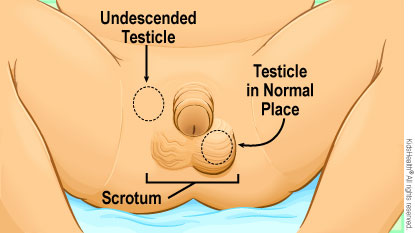Undescended testicle (also known as cryptorchidism) is when one or both of a baby boy's testicles have not moved down into their proper place in the scrotum.
An undescended testicle may come down on its own in the first few months of life. If it doesn't come down by 6 months of age, surgery is recommended.



Your baby seems fussy or vomits more than a few times. This might be a sign of twisting of the testicle (testicular torsion).

Your baby:

Are there risks from having an undescended testicle? There are some risks, such as:
Surgery to bring the testicle into the scrotum can help lower these risks. It's best for this surgery to be done before a child is 2 years old.
What is the surgery for an undescended testicle? Usually, the surgery is an orchiopexy (or-kee-oh-PEK-see). In this procedure, the surgeon makes a small cut in the groin, brings the testicle down into the scrotum, then stitches it in place. Most babies go home the day of the surgery and recover fully within a week.